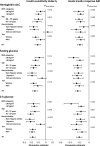A1C between 5.7 and 6.4% as a marker for identifying pre-diabetes, insulin sensitivity and secretion, and cardiovascular risk factors: the Insulin Resistance Atherosclerosis Study (IRAS)
- PMID: 20573754
- PMCID: PMC2928372
- DOI: 10.2337/dc10-0679
A1C between 5.7 and 6.4% as a marker for identifying pre-diabetes, insulin sensitivity and secretion, and cardiovascular risk factors: the Insulin Resistance Atherosclerosis Study (IRAS)
Abstract
Objective: A1C is an optional method for diagnosing diabetes and also for detecting individuals at increased risk of the disease. However, how A1C compares with fasting (FPG) and 2-h plasma glucose for detecting at-risk individuals is not well known.
Research design and methods: A 2-h glucose tolerance test, frequently sampled intravenous glucose tolerance test, and A1C were obtained at the follow-up examination in 855 participants in the Insulin Resistance Atherosclerosis Study (IRAS). For this report, 385 individuals were at increased risk of diabetes as defined by A1C between 5.7 and 6.4%, impaired glucose tolerance (IGT), and/or impaired fasting glucose (IFG).
Results: IFG and IGT identified 69.1 and 59.5% of all individuals at increased risk of diabetes, respectively. A1C 5.7-6.4% detected 23.6% of all at-risk individuals, although more African Americans (31.4%) and Hispanics (35.2%) than non-Hispanic whites (9.9%). Relative to A1C, FPG was more strongly related to fasting insulin (r = 0.38 vs. 0.26; P < 0.01), acute insulin response (r = - 0.20 vs. - 0.09; P < 0.01), and waist circumference (r = 0.43 vs. 0.25; P < 0.001) by the Spearman correlation test. Similarly, 2-h plasma glucose was more strongly related to Si (r = - 0.40 vs. - 0.27; P < 0.01) and triglycerides (r = 0.30 vs. 0.08; P < 0.001).
Conclusions: A1C 5.7-6.4% is less sensitive for detecting at-risk individuals than IFG and IGT, particularly among non-Hispanic whites. Single determinations of FPG and 2-h plasma glucose seem to be more precise correlates of insulin resistance and secretion than A1C and, in general, better for other metabolic disorders.
Figures

References
-
- Droumaguet C, Balkau B, Simon D, Caces E, Tichet J, Charles MA, Eschwege E: DESIR Study Group. Use of HbA1c in predicting progression to diabetes in French men and women: data from an Epidemiological Study on the Insulin Resistance Syndrome (DESIR). Diabetes Care 2006;29:1619–1625 - PubMed
-
- Inoue K, Matsumoto M, Akimoto K: Fasting plasma glucose and HbA1c as risk factors for type 2 diabetes. Diabet Med 2008;25:1157–1163 - PubMed
Publication types
MeSH terms
Substances
Grants and funding
LinkOut - more resources
Full Text Sources
Medical

